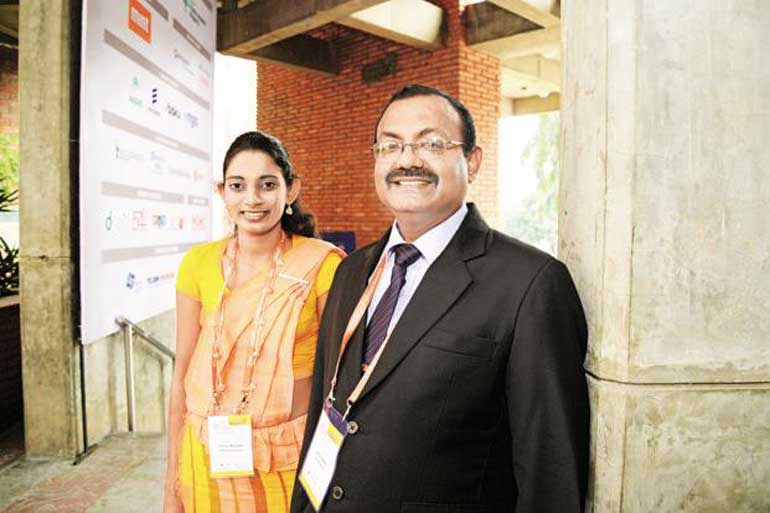Thursday Nov 06, 2025
Thursday Nov 06, 2025
Thursday, 6 August 2015 00:00 - - {{hitsCtrl.values.hits}}
 Sri Lanka Post Head of ICT T.M.D. Ekanayake (right) – Ramesh Pathania/Mint
Sri Lanka Post Head of ICT T.M.D. Ekanayake (right) – Ramesh Pathania/Mint
By Saurabh Kumar
www.livemint.com: In Sri Lanka, around 80% of the population lives in rural areas. According to government data, among its 18 districts, Colombo has the highest urban population (54.6%), followed by Ampara at a distant 19%. Some districts such as Polonnaruwa and Moneragala are fully rural.
Though the number of bank branches per 100,000 people at 14.12 for Sri Lanka is better compared with India’s 10.6, most of them are in urban areas.
“Rural areas in Sri Lanka do not usually have banks,” said Sri Lanka Post Information Communication Technology Division Head T.M.D. Ekanayake. However, the country has a decent network of post offices. There are 654 post offices in cities and 3,410 sub-post offices, one in each village.
These sub-post offices have now become the financial lifeline of these villages, thanks to a project called M-ePay. Till mid-2014, these sub-post offices delivered money, apart from letters and parcels, by hand.
“Often, it would take days for it to reach the destination, sometimes even weeks,” said Ekanayake. It takes a long time to deliver to places such as villages around Anuradhapura in the North Central Province, which are covered with dense jungle.
In 2014, the postal department came up with a solution to use these post offices to reduce the time it took for money to travel. The solution, called M-ePay, connected all sub-post offices through mobile phones to main post offices; the main post offices were already connected to the central government’s servers through the internet.
Now, for payments such as electricity or phone bills, money transfers and payments such as Employees’ Provident Fund and Employees’ Trust Fund, all it takes is a minute. Customers can walk in to the sub-post office and pay these bills by quoting the bill number and making the payment to the postmaster.
The innovation received a special mention in the m-governance category of the 2015 mBillionth awards.
Under the new system, every postmaster at sub-post offices has a user identity to access the server to make these payments through text messages. “All it takes is a pre-formatted text from the postmaster’s registered mobile number for any such payment and, immediately, he gets a reply when the transaction is done,” said Ekanayake. High-end phones are not required, since these transactions are based on text messages.
“Given the limitations of non-availability of internet, it sounds like a great standalone innovation because it is very simple,” said Krishnan Dharmarajan, Executive Director, Centre for Digital Financial Inclusion, an Indian think tank.
The customer, however, does not get any confirmation message, but gets an acknowledgement slip. “Usually, people in villages have very high regard for the postmaster at the post office, who is very close to them. So, they do not hesitate to hand over money,” said Ekanayake.
Dharmarajan also believes that it will work because people in this part of the world have a lot of trust in postmasters. “It is about winning the trust of the customers,” he said.
The sub-post offices could not be connected through the internet because data services are usually not available in these areas, though 96% of the country is covered by mobile networks.
Initially, the transactions were done manually, leading to a large number of errors, which have since come down. It has also increased efficiency as there is not much paperwork involved. The M-ePay platform promises to extend the access of existing government services to all citizens and expand the delivery of new services.
“Our aim is to provide convenient services to rural areas through new technologies, thereby increasing customer base and earn profits as well,” said Ekanayake. The service is free for customers; the department charges service providers.
From 1 June 2014, the date of M-ePay’s launch, till 31 March 2015, the postal department has earned around Rs. 64 lakh through 396,040 electricity bill payment transactions, around Rs. 1.3 lakh from 8,540 phone bill payments, and around Rs. 3.7 lakh from 5,537 money transfers.
“I believe it can be replicable in many other countries, and many parts of India as well, given many of them operate under similar circumstances,” said Dharmarajan. However, he said that since basic mobile services are available in most of Sri Lanka, the postal department should make use of the system.
“Maybe customers can be sent a message to their mobile phones. This will provide greater measure of assurance to customers who would be able to track their payments,” added Dharmarajan, adding that it would be cheaper to send acknowledgements via text messages, rather than giving printed slips.